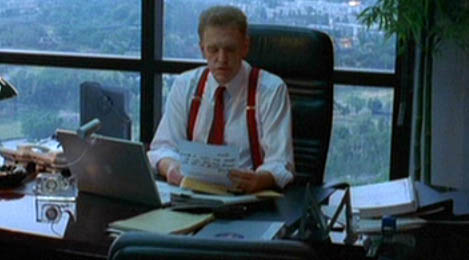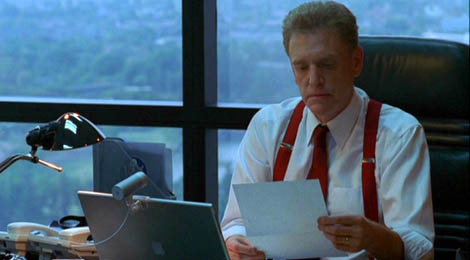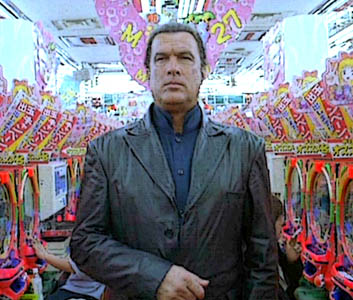|
Into the Sun is the latest in Steven Seagal's seemingly infinite series of straight-to-vid action pictures in which he works for or used to work for the CIA, loses one or more loved ones in some way, and incorporates stylized Asian fighting techniques into his revenge and/or rescue. IMDb says he has made nine pictures in the new millennium, and this one is ranked in the top half.
I have not seen Clementine but amazingly, I have seen all of the others, and I'd say that IMDb ranking gives a fair picture. Into the Sun is not as good as Exit Wounds, but is very comparable to Belly of the Beast in many ways, and is a better film than the others on the list. I was ready to write Big Steve off in mid-2003, but Seagal continues to make a pretty decent little comeback after his back-to-back 2003 disasters with director Hounddog Oblowitz (the two lowest rated films above). There are some reasons why the Bulky Battler's career is recovering:
So my hat is off to the Chubby Commando for grabbing his career by the horns and taking personal control of it. I don't know if he's going to make it back into theatrical releases, but the quality of his video offerings is definitely on the rise. If you like his brand of Asian gangster pictures, this is a pretty decent one. Not that there aren't some good things to make fun of: There's continuity, for example. These images are actually cropped from adjacent frames in the film. Notice any problem? |
||
|
|
|
|
|
What happened to the message scrawled in black magic
marker? If the director had cut away to a picture of Seagal (the author of the letter) staring off into the middle distance, then cut back to Atherton here, I might never have noticed, but ... adjoining frames? How could I miss it? I know that both characters worked for the CIA. Maybe the message was written in disappearing ink. On the other hand, in that case I'm not sure why Atherton kept reading from it after it disappeared! And then there's the dialogue. Check this shit out ... |
||
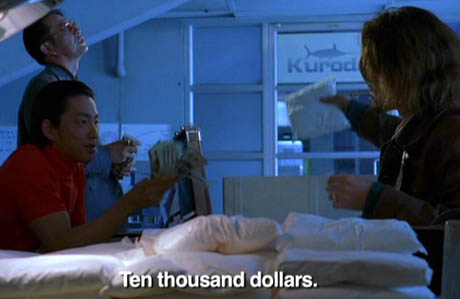 |
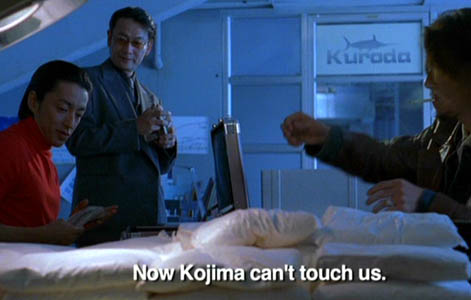 |
|
|
Woo-hoo! Ten thousand dollars! Tokyo is mine! Mua-ha-ha-ha!
(Raise pinky to lips.) Ten thousand dollars in Tokyo won't buy them a decent steak dinner. |
||
 |
And then there is the DVD box. I swear to you, that
scene on the left has absolutely nothing to do with this movie. Looks cool. May have happened in another film. Not in this one. The colorful scene on the right might have made a cool cover for THIS film's DVD, especially since the director went to the trouble of getting it all framed and symmetrical. |
|
| Finally, there is the plot. The CIA has to figure out how Kuroda, a Yakuza boss, is getting heroin around Tokyo. Gee, let me think. He runs a fish company called the Kuroda Fish Company, and they deliver stuff all around Tokyo. OK. I'm ready to make my guess ... | ||
|
|
||
|
... I'm going to go out on a limb here and say that
Kuroda the crime boss delivers his stuff around Tokyo in the trucks
marked "Kuroda". The regular and special CIA agents were not able to figure this out. I guess they figured that since Kuroda carted fish around in a truck marked with his name and a fish symbol, he would cart heroin around in a truck marked with his name and a poppy. Those foolish Westerners! Will they never understand the subtlety of the Asian mind? Luckily, the cultural virgins were able to call in the Stout Swordsman, a certain pony-tailed super special agent who grew up in Tokyo, and the big man duped it all out with his intimate knowledge of Asian cultures. Of course, before the Fleshy Fencer could bring the baddies to justice, they had killed his sensei, his fiancée, and his partner, but ... well ... those are the sacrifices one must make for straight-to-video honor. |
||
